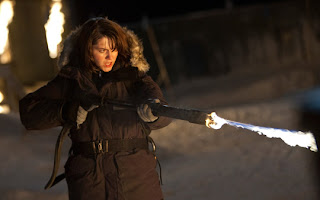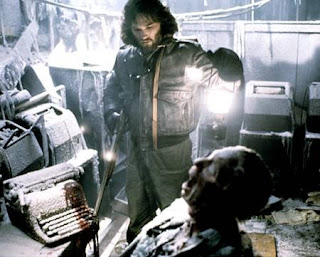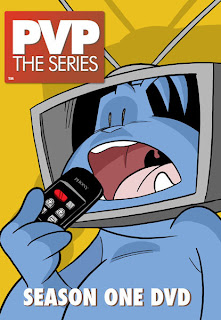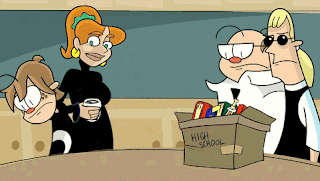J.R.R. Tolkien/Christopher Tolkien,editor
Illustrated by Ted Nasmith
Houghton Mifflin Company, 2004
$40.00
First, let me tell what TheSilmarillion is. It is J.R.R. Tolkien's legendarium, orcompilation of stories, of the First Age of Middle Earth. They arefor the most part set many thousands of years before Frodo ever cameinto possession of the One Ring. Now let me tell what TheSilmarillion is not. It is not a prequel of any sort to TheLord of the Rings, although the tales found within it are indeedthe ultimate backstory of that trilogy.
The Silmarillion was notpublished until 1977, four years after Tolkien's death. The storiesthat form it, though they had been worked on by the learned professorsince the First World War, were not set down in a truly completedstate at the time of his passing. The task of hammering his writingsinto publishable form was left to his son, Christopher Tolkien, aidedby the young Guy Gavriel Kay, who would later achieve fame as afantasy author in his own right.
This was not an easy orstraightforward task. In many instances Tolkien's thoughts on hisstories changed over time, and required his son to pick and chooseamongst various narrative strands. There were also some serious gapsin the story. There is a definite end to the the tale of the FirstAge, but getting there required the introduction of some supplementalmaterial by Christopher.
It is a commonplace that Tolkien wasdeeply interested in languages, being as he was a professor of suchthings, and this interest comes across markedly in his writings. Insome cases, his interest in words actually drove his writings, andthey contain a marvelous depth because of his philological efforts. There was also Tolkien the philosopher, who interwove his storieswith much that was derived from his Christian, specifically Catholic,heritage and beliefs.
The beginning of The Silmarillionis undeniably religious in tone, if not on a theological basis. Iluvatar (the One; God) makesappearances, as do his angels, called here the Ainur. A number of these are sent into the created world, Arda, to act asdemiurges and guardians. These are the Valar,or archangels, and the maiar,or lesser angels, who aid their superiors the Valar in their tasks.
The Valar dwell in glory in Valinor,in the far west of Arda, under the kingship of Manwe, and go aboutreadying the world for the coming of the Children of Iluvatar, theElves and Men. There is only one problem that troubles them, andthat is that the mightiest and greatest of all the Valar, Melkor, isalso a first-class jerk. Melkor is the Satan-figure of thissoon-to-be lost paradise, and he corrupts and mars all that hetouches in his bid for selfish domination. You might ask yourselfwhy Iluvatar allowed this wretched miscreant, who caused trouble inHeaven even before the creation of the world, to gain entryinto this new realm. This is nowhere answered, at least notsatisfactorily, and you will have to content yourself with knowingthat it is Melkor who will at least provide the dramatic tension thatmakes The Silmarillion great.
Back to the Children. The Elves,immortal and beautiful, are the firstborn children of Iluvatar, andawake in the far east of Middle-earth. They are also bereft of anyreal means to defend themselves from the depredations of Morgoth, whohas established a fortress, Utumno, in the frozen north. From therehe preys upon the Elves, snatching some whom he will twist into thefirst of the orcs.
The Valar bestir themselves to emergefrom their splendid isolation in the western paradise of Valinor, andattack Melkor, taking him captive, and destroying Utumno, albeit notcompletely. The Elves are summoned to join the Valar in the west,and begin a long trek across the face of Middle-earth to the ocean,and thence to Valinor. Some stay behind, and among these are theancestors of the latter-day elves of the woodlands, such as Legolas. Others travel all the way, and become inhabitants of the Valar'sBlessed Realm. Among them is the kindred of the Noldor, who areconsidered to be the most learned and skilled in craft of all theElves. The Noldor are also the most headstrong and willful of theirrace, restless and proud.
Unwisely, the Valar in time releaseMelkor from his long captivity, thinking that he is reformed andrepentant. He is not. Melkor goes amongst the Elves, especially theNoldor, stirring up things, and causing them to chafe at what theydeem to be their confinement in Valinor.
One of the leaders of the Noldor'sdiscontent is Feanor, the greatest craftsman that the Elves or anyother race will ever produce. He creates the Silmarils, threeincomparable gems that capture the holy radiance of the Two Treeswhich provide brilliant light for Valinor. But he is jealous of hisjewels, and also of his station, especially when his father, Finwe,the king of the Noldor, remarries after the death of Feanor's ownmother. He develops a dislike of the Valar, but never allies himselfwith Melkor either, whose anti-Valar poison he nevertheless imbibes.
Melkor, covetous of shiny things,steals the Silmarils, and slays King Finwe, who perishes guardingthem. The Two Trees are sucked dry by a great spider in league withMelkor named Ungoliant. Melkor flees to the North again, where hetakes up residence in another of his fortresses, Angband, and recallsto there all of his servants who survived the incomplete destructionof Utumno.
Feanor vows revenge and follows afterhim, killing innocent Elves who stand in his way. Many other Noldorreturn to Middle-earth, not so much to follow Feanor, but to seekvengeance for their murdered king, and to rule for themselves theirown realms free from the tutelage of the Valar.
This proves to be a gigantic mistake. Great crimes were committed by Feanor on his way out of Valinor, andso the Valar impose a blanket ban on a return trip by all of theNoldor, even for those that bitterly regret their departure. TheNoldor will be essentially on their own against the most powerfulbeing in all the world and his legions of orcs, dragons, and balrogs. Their quest to avenge their king and regain the Silmarils is doomedto failure, they are dramatically warned by the Valar, and they willshed unnumbered tears in the futile attempt. Feanor himself is slainby balrogs soon after the return to Middle-earth, and he realizes ashe lays dying that the Noldor will never overcome Morgoth.
Got all that?
The foregoing gets you about one-thirdof the way through The Silmarillion, and the great war ofElves (and in time, Men) with Morgoth has yet to be told. But all ofthis is necessary for Tolkien's design to succeed. We must know theorigin of all the players, their motivations, and backgrounds, sothat their actions are explicable within the intricate secondaryreality invented by the learned professor. It can at times be slowgoing. There is a biblical quality to The Silmarillion, andindeed, a criticism leveled against it over the years is that it istoo much like the Bible, and not enough like The Lord of theRings. More specifically, The Silmarillion is notnovelistic in its form, but is instead a collection of interlinkedstories, generally arranged chronologically.
This criticism, as old as it is,misses the point of The Silmarillion. It is not a novel,although portions of it contain somewhat similar pacing and characterdevelopment. It is more akin to a compilation of ancient sagas,with which Tolkien was well-familiar.
And how does The Silmarillionwork as fiction? The finest tales, I think, combine the particularsof Middle-earth with age-old themes. Of Beren and Luthien is aRomeo and Juliet love story as rich as any from literature. It could easily be made into a motion picture as vivid and engagingas The Lord of the Rings. Are you listening Peter Jackson? It could be the first billion-dollar grossing romantic fantasy filmto win an Academy Award. Of Turin Turambar is a tragedy ofShakespearean dimension, darkly Nordic in its tale of a noble butdoomed hero, whose fate overwhelms all chance for happiness. Ofthe Voyage of Earendil and the War of Wrath has a strongsoteriological theme, in which the remaining Elves and Men ofBeleriand are saved by a mission of mercy of the mariner Earendil tothe now-ready-to get-over-their-anti-Noldor snit Valar in theUttermost West.
Also included in the book are theAkallabeth, the story of the drowning of the human realm ofNumenor, in an Atlantis-style cataclysm, and Of the Rings of Powerand the Third Age, which retells, in greatly abbreviated form,the story of the One Ring and the war that concluded with itsdestruction in Mount Doom. These are both set long after the primarystory of the First Age and the Silmarils (which is officially calledthe Quenta Silmarillion, if you must know) but both flesh outkey elements of the background of The Lord of the Rings. Theformer explains the origin of the Kingdom of Gondor, founded as itwas by refugees from the drowned island-civilization of Numenor, andthe latter describes the making of the Rings of Power and why theElves (those headstrong Noldor again) were a trifle unwise to makethem.
What makes this 2004 edition specialare Ted Nasmith's illustrations, which are uniformly excellent, andmatch closely what is described on the page. Nasmith generally workswith a limited palette of colors, but one still noticeably wider thanhis contemporary Tolkien artist, Alan Lee. The forty-five paintingsare evocative of the setting, and truly do add something to theexperience of reading the book. They are not necessary for itsenjoyment, but this hardcover is worthwhile, especially if you are adedicated fan of Tolkien. Also included is a frameable map ofBeleriand, that part of western Middle-earth where the great waragainst Morgoth takes place.
By Marc
 Star Fluxx, the latest in the Fluxx series of card games from Looney Labs, brings the players into the world of science fiction and outer space (not to be confised with Martian Fluxx, which brought alien invaders to Earth). This new game isn't very different from previous versions of Fluxx, but it is pretty fun.
Star Fluxx, the latest in the Fluxx series of card games from Looney Labs, brings the players into the world of science fiction and outer space (not to be confised with Martian Fluxx, which brought alien invaders to Earth). This new game isn't very different from previous versions of Fluxx, but it is pretty fun. There are very few changes in terms of gameplay in Star Fluxx, and anyone who's played a previous incarnation of Fluxx will be able to play this one without glancing at the rules. The main appeal of Star Fluxx is for sci-fi fans. This game has plenty of allusions to science fiction classics, like Star Wars (the Laser Sword, These Aren't the Droids...), Star Trek (the Expendable Crewman -- in red shirt, naturally -- and Energy Crystals), Doctor Who, Forbidden Planet, and even The Hitchiker's Guide to the Galaxy. Some cards have interesting effects, like the Wormhole (which lets each player draw and play the top card from the deck without looking at it), the Time Portal (which lets you take a card from "the past" (discard deck) or "the future" (draw deck)), and Brain Transference, which makes two players switch seats and take over the other's position in the game! It also happened that in one game the Cute Fuzzy Alien Creature was turned Evil, and next game the critter was infested with Brain Parasites.
There are very few changes in terms of gameplay in Star Fluxx, and anyone who's played a previous incarnation of Fluxx will be able to play this one without glancing at the rules. The main appeal of Star Fluxx is for sci-fi fans. This game has plenty of allusions to science fiction classics, like Star Wars (the Laser Sword, These Aren't the Droids...), Star Trek (the Expendable Crewman -- in red shirt, naturally -- and Energy Crystals), Doctor Who, Forbidden Planet, and even The Hitchiker's Guide to the Galaxy. Some cards have interesting effects, like the Wormhole (which lets each player draw and play the top card from the deck without looking at it), the Time Portal (which lets you take a card from "the past" (discard deck) or "the future" (draw deck)), and Brain Transference, which makes two players switch seats and take over the other's position in the game! It also happened that in one game the Cute Fuzzy Alien Creature was turned Evil, and next game the critter was infested with Brain Parasites. "If it works, don't fix it" may be Looney Labs' unofficial motto for the Fluxx games, as they keep the format the same while changing genres with each edition. Star Fluxx is further support for this theory, and while it'll be very familiar if you're played any previous version of Fluxx, it's still pretty fun -- especially if you're a science fiction fan.
"If it works, don't fix it" may be Looney Labs' unofficial motto for the Fluxx games, as they keep the format the same while changing genres with each edition. Star Fluxx is further support for this theory, and while it'll be very familiar if you're played any previous version of Fluxx, it's still pretty fun -- especially if you're a science fiction fan.


























